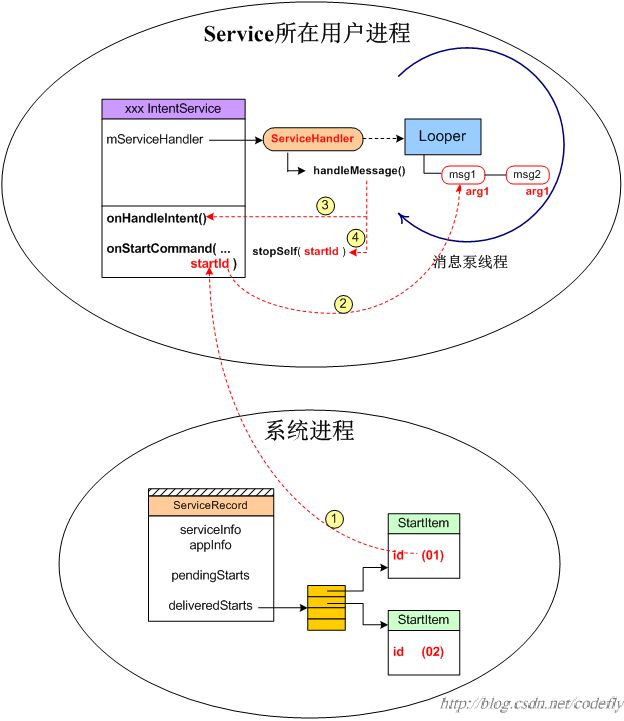详细剖析IntentService的运作机理
1 概述
在讲述Service机制的文章里,我们曾经稍微提起过IntentService,今天再来详细剖析一下它。说起来,IntentService只是一个处理异步请求的服务基类而已。当人们通过调用startService()启动IntentService时,实质上是向其发送了一个请求。而如果有多个地方同时向同一个IntentService发送请求的话,那么这些请求会被串行化处理。所以,IntentService常常用于执行那种“一次性处理”的工作。IntentService的运作机理相对比较简单,而且从Android2.3(我手头最早的版本)到Android5.1,IntentService的实现代码一直就没怎么变动过,可见其稳定程度。
当然,我们既然说要详细剖析IntentService,就不可能仅仅讲这么点儿东西。我们可以挖得再深一点儿,看看IntentService到底是如何实现的,又是如何保证串行处理工作的。现在我们就开始吧。
2 先简单说说IntentService的运作
2.1 onCreate()中启动一个消息泵线程
我们先看一下IntentService的onCreate()函数:【frameworks/base/core/java/android/app/IntentService.java】
@Override
public void onCreate() {
super.onCreate();
HandlerThread thread = new HandlerThread("IntentService[" + mName + "]");
thread.start();
mServiceLooper = thread.getLooper();
mServiceHandler = new ServiceHandler(mServiceLooper);
}ServiceHandler是IntentService的一个内嵌类,其定义如下:
private final class ServiceHandler extends Handler {
public ServiceHandler(Looper looper) {
super(looper);
}
@Override
public void handleMessage(Message msg) {
onHandleIntent((Intent)msg.obj);
stopSelf(msg.arg1); // 注意,不是stopService()!
}
}2.2 onStartCommand()利用ServiceHandler向消息泵打入特殊消息
在紧随onCreate()函数之后,系统会调用到onStartCommand()函数,这个大家都很熟悉了。对于startService()动作而言,系统只会在service尚不存在的情况下,创建相应的service,并回调其onCreate()函数。以后,只要这个service没有被销毁,就不会重复再调用onCreate()了。不过,每次调用startService()都会导致走到onStartCommand()函数。IntentService的onStartCommand()函数的代码如下:
@Override
public int onStartCommand(Intent intent, int flags, int startId) {
onStart(intent, startId);
return mRedelivery ? START_REDELIVER_INTENT : START_NOT_STICKY;
}@Override
public void onStart(Intent intent, int startId) {
Message msg = mServiceHandler.obtainMessage();
msg.arg1 = startId;
msg.obj = intent;
mServiceHandler.sendMessage(msg);
}看起来,每当用户调用startService()启动IntentService,就会自动向其内部消息泵线程打入一条消息,该消息的.obj域记录着用户传来的intent,这个intent在handleMessage()里会进一步传递给onHandleIntent()。另外,请大家注意那个startId参数,这里我们先打个伏笔,后文还会细说。
2.3 实现你的onHandleIntent()函数
在IntentService.java文件里,onHandleIntent()只是做了简单的声明:
protected abstract void onHandleIntent(Intent intent);消息泵里的消息队列在先天上就维护了一条串行化的执行链。消息泵线程逐个摘取消息节点,回调每个节点的onHandleIntent()函数,一切都显得那么自然。现在我们可以画出如下示意图:
3 再深挖一下
有了以上这些基础知识,现在我们要再深挖一下了。在消息队列中,消息的确被顺序排列了,可是在处理前一个消息时,调用的stopSelf()不是把service结束了吗?那它还怎么保证继续处理后续消息呢?可见,前文我们说的“IntentService还会自动执行stopSelf()关闭自己”的说法并不准确。问题的关键在于,ServiceHandler的handleMessage()里调用的是stopSelf(),而不是stopService()!它们是不一样的。
3.1 stopSelf()和stopService()是不一样的!
stopSelft()的函数定义如下:【frameworks/base/core/java/android/app/Service.java】
public final void stopSelf(int startId) {
if (mActivityManager == null) {
return;
}
try {
mActivityManager.stopServiceToken(
new ComponentName(this, mClassName), mToken, startId);
} catch (RemoteException ex) {
}
}AMS中启动service的函数是startService,其代码截选如下:
【frameworks/base/services/core/java/com/android/server/am/ActivityManagerService.java】
public ComponentName startService(IApplicationThread caller, Intent service,
String resolvedType, int userId) {
. . . . . .
. . . . . .
ComponentName res = mServices.startServiceLocked(caller, service,
resolvedType, callingPid, callingUid, userId);
. . . . . .
. . . . . .
}【frameworks/base/services/core/java/com/android/server/am/ActiveServices.java】
ComponentName startServiceLocked(IApplicationThread caller,
Intent service, String resolvedType,
int callingPid, int callingUid, int userId) {
. . . . . .
ServiceRecord r = res.record;
. . . . . .
r.lastActivity = SystemClock.uptimeMillis();
r.startRequested = true;
r.delayedStop = false;
r.pendingStarts.add(new ServiceRecord.StartItem(r, false, r.makeNextStartId(),
service, neededGrants)); // 注意这里的r.makeNextStartId()
. . . . . .
. . . . . .
return startServiceInnerLocked(smap, service, r, callerFg, addToStarting);
}生成id号时,采用的办法是最简单的加1操作,代码如下:
【frameworks/base/services/core/java/com/android/server/am/ServiceRecord.java】
public int makeNextStartId() {
lastStartId++;
if (lastStartId < 1) {
lastStartId = 1;
}
return lastStartId;
}接下来,我们绘制一张调用关系图:
图中的sendServiceArgsLocked()会将r.pendingStarts列表中的StartItem节点转移到r.deliveredStarts列表中。这主要是因为启动service的动作本身是比较复杂的,有时候甚至会遇到目标service寄身的进程尚未启动的情况,此时就得先启动一个用户进程,而后再进一步启动service。要规划好这些异步的动作,我们常常需要把信息先记录进一个pending列表里,而后再在合适的时机将信息从pending列表里取出。
上图中最后调用的r.app.thread.scheduleServiceArgs()其实是向service所在的进程发出SERVICE_ARGS语义,语义中携带着刚取出的StartItem节点的id和intent信息。该语义最终导致执行到目标service的onStartCommand()。这个就和前文介绍onStartCommand()的地方契合起来了。
当onStartCommand()向消息泵线程打入消息时,startId就被记录进message里了。我们现在举个例子,假设几乎在同时有两个地方都调用startService()来启动同一个IntentService,此时很可能会形成两个StartItem和两个IntentService消息,画出示意图如下,图中以msg1为基准,绘制了逻辑上的执行路径,请大家注意图中的逻辑序号。
既然消息队列里的消息已经和AMS里的StartItem对应上了,那么在处理完消息后,调用stopSelf()时,应该也必须考虑到这种匹配关系。所以stopSelf()的参数就是startId。前文我们已经看到,stopSelf()内部是在调用:
mActivityManager.stopServiceToken(
new ComponentName(this, mClassName), mToken, startId);【frameworks/base/services/core/java/com/android/server/am/ActivityManagerService.java】
@Override
public boolean stopServiceToken(ComponentName className, IBinder token,
int startId) {
synchronized(this) {
return mServices.stopServiceTokenLocked(className, token, startId);
}
}【frameworks/base/services/core/java/com/android/server/am/ActiveServices.java】
boolean stopServiceTokenLocked(ComponentName className, IBinder token, int startId) {
. . . . . .
ServiceRecord r = findServiceLocked(className, token, UserHandle.getCallingUserId());
if (r != null) {
if (startId >= 0) {
ServiceRecord.StartItem si = r.findDeliveredStart(startId, false);
if (si != null) {
// 用while循环删除位于startId对应的StartItem节点以及其之前的所有节点
while (r.deliveredStarts.size() > 0) {
ServiceRecord.StartItem cur = r.deliveredStarts.remove(0);
cur.removeUriPermissionsLocked();
if (cur == si) {
break;
}
}
}
if (r.getLastStartId() != startId) {
return false; // 如果不是最后一个startItem节点,则直接return false了
}
if (r.deliveredStarts.size() > 0) {
Slog.w(TAG, "stopServiceToken startId " + startId
+ " is last, but have " + r.deliveredStarts.size()
+ " remaining args");
}
}
. . . . . .
// 当最后一个startItem摘掉后,才真正结束service
bringDownServiceIfNeededLocked(r, false, false);
. . . . . .
return true;
}
return false;
}那么,为什么要用一个while循环来删除位于startId对应的StartItem节点之前的所有节点呢?大家可以设想一下,如果service进程被异常kill了,那么它里面的消息队列肯定也就销毁了。可是在AMS一侧的ServiceRecord里,那些对应的StartItem节点还是存在的,就好像一个个孤儿一样。此时,如果用户再一次调用startService()启动了这个IntentService,那么系统最好能在处理完此次message后,一并将那些孤儿StartItem销毁。不过这只是我目前的一点儿猜想,实际上可能不大容易遇到这种情况。
3.2 说说setIntentRedelivery()
现在我们再来看看IntentService里其他一些细节。比如setIntentRedelivery()函数:【frameworks/base/core/java/android/app/IntentService.java】
public void setIntentRedelivery(boolean enabled) {
mRedelivery = enabled;
}我们再列一次onStartCommand()的代码:
public int onStartCommand(Intent intent, int flags, int startId) {
onStart(intent, startId);
return mRedelivery ? START_REDELIVER_INTENT : START_NOT_STICKY;
}4 小结
有关IntentService的知识,我们就先说这么多,有兴趣的同学不妨对比代码看看。


